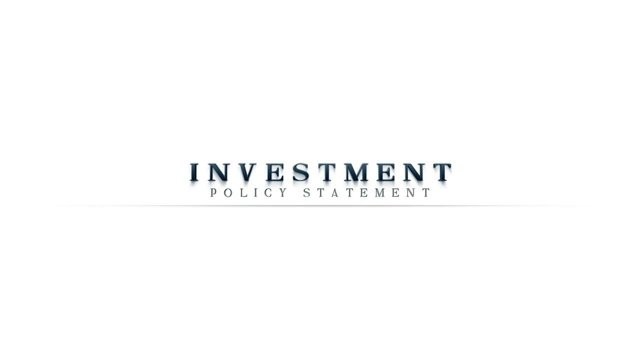Making Your Investment Policy Statement
Post on: 15 Июль, 2015 No Comment

It’s a great practice to create an investment policy statement. It can help you articulate the key reasons why you’re investing, what you’re hoping to gain from your investments, whether you’re on track to meet your goals, and whether any changes are in order.
Once you’ve created one, you can use your investment policy statement as your compass, a check to keep your investment portfolio on course to meet its goals even when the market and your emotions are telling you to run for the hills. Referring to your investment policy statement before you make any investment decisions can help ensure that you’re investing with your head, not your gut.
Corporations and big institutional investors like pension plans create elaborate, 20-page investment policy statements. However, you needn’t hire a consultant to develop your investment policy statement, and you don’t have to use consultant-ish terms like Executive Summary and Reporting Requirements, even though they appear in a lot of investment policy statements prepared by the pros.
In fact, the best investment policy statements for individuals are fairly stripped down and written in plain English; that way, you’ll be able to easily identify the things that you should be focusing on.
If you have separate investment portfolios geared toward different investment goals—for example, you have your own retirement assets that you expect to tap in 20 years as well as a education savings plan for your 15-year-old—you may find it helpful to create separate investment policy statements for each sleeve of your portfolio. Don’t get too carried away, though. By getting too complicated and creating too many sleeves of your portfolio, you risk getting bogged down in paperwork and missing the big picture about whether your investments are on track to get you to your goals.
Using Morningstar’s Investment Policy Statement (PDF) as your template, start by writing down your key investing goal and the year in which you hope to reach it. If it’s a goal that you will pay for over a number of years, such as retirement or college, fill out the Duration field. Of course, when it comes to retirement, filling out this field means quantifying your own longevity. It’s tricky. Use the country’s average life expectancy rates to arrive at a reasonable estimate. From there, it’s helpful to be optimistic and assume even greater longevity: Add at least a few years.
To the extent that you can, quantify how much your goal will cost. If you have a financial goal that’s more than a year or two away, it’s important to adjust the cost upward to reflect what you’ll actually pay once inflation is factored in. That gets even more complicated for goals you expect to fund over several years, such as retirement or college.
Go online or refer to your most recent statements to arrive at the current value of the investment assets you have earmarked for that specific goal. Also indicate how much you plan to invest toward this goal on an ongoing basis.
Next, document your asset allocation targets for these investments.
Because your portfolio’s asset allocation will ebb and flow based on how stocks are performing versus bonds and cash, your investment policy statement should set a range for your asset allocation rather than targeting a static figure for each asset class. After all, you don’t want to have to make changes to your portfolio just because stocks went up 5% over the past month; that kind of trading can be costly and time-consuming.
For the broad asset classes, a range of 10 percentage points (or even 15 or 20 percentage points if you’d like to be a hands-off investor) is reasonable. For example, say your asset allocation target for your retirement portfolio is 55% stock, 40% bonds, and 5% cash. In your investment policy statement, you’d set out the ranges as follows:
Stocks: 50% to 60% Bonds: 35% to 45% Cash: 0% to 10%
Some investment policy statements include sub-asset-class breakdowns, setting parameters for large-, mid-, and small-cap stock exposure; you can also break out domestic and foreign stock exposure. There’s nothing wrong with that, but you don’t need to get too fancy. Setting your exposure to the broad asset classes and keeping your portfolio in line with those parameters is most important.
Based on your asset allocation parameters, project a rate of return for your portfolio. That will require you to forecast rates of return for various asset classes, a task that’s certainly more art than science. But you may use a long-term historical returns for asset classes and a bit of conservatism to arrive at an estimate.
If your account consists of some combination of stocks, bonds, and cash, you’ll need to come up with a combined expected return.
Next, document what you’re looking for in your individual investments: the criteria you used when you selected the securities in your portfolio and what you’ll use to judge them on an ongoing basis.

- Some worthwhile criteria for do-it-yourselfers include:
- Manager tenure of more than five years
- Holds up well in down markets
- Average credit quality of A or better (for bond funds)
- Long-term (10-year or more) returns in top half of peer group or beating appropriate market benchmark
Once you’ve set your asset allocation parameters and your criteria for individual security selection, your next step is to specify how often you’ll check up on your portfolio and when you’ll make changes. In my experience, less is usually more when it comes to checking up on your holdings and your portfolio’s performance.
Semiannual or quarterly (at most) portfolio checkups are more than adequate. When it comes to making changes, we’d recommend doing so when your checkups indicate that your portfolio’s allocations to the broad asset classes have diverged from your target by 5 or 10 percentage points or more.
The final step in creating an investment policy statement is to specify what your checkups will consist of and how you’ll evaluate whether you’re on track to meet your goals.
You can do so in a few separate ways:
- Monitor individual holdings versus the criteria you laid out in Step 6.
- Monitor portfolio’s asset allocation versus target allocation. (This will be the main trigger for your rebalancing efforts.)
- Monitor individual holdings’ performance versus an appropriate benchmark.
- Monitor aggregate performance of holdings within an asset class versus a benchmark geared toward that asset class.
- Monitor portfolio’s rate of return versus the projected rate of return you articulated in Step 5.
- Monitor assets accumulated versus your goal.
If you’re familiar with investment policy statements, you know that they often include a couple of features that we’ve omitted here. For starters, they often include an investor’s assessment of his or her own risk tolerance. In reality, however, most investors are very poor judges of their own ability to tolerate risk; when stocks are going up they rate their risk tolerance as very high, but when everything’s going down, they feel more conservative. Because it’s not very useful, we didn’t include risk tolerance here.
Many investment policy statements also focus on performance, setting out rigid parameters such as fund must be in top half of peer group over trailing three-year period. I think that, too, is misguided, because most investments lag their peer groups from time to time, and short-term underperformance can have a big effect on a holding’s longer-term numbers. To the extent that your investment policy statement mentions performance, it should be very long-term.
The article first appeared on Morningstar.com. our sister US site, and has been formatted for India. Christine Benz is director of personal finance for Morningstar.














